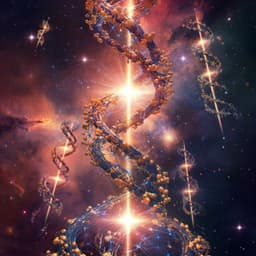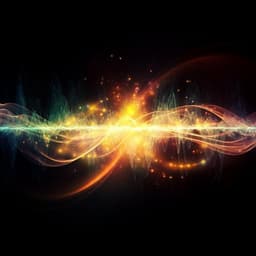
Physics
Symmetry of magnetic correlations in spin-triplet superconductor UTe₂
N. P. Butch, S. Ran, et al.
Discover the fascinating impact of superconductivity on low-energy magnetic excitations in the spin-triplet superconductor UTe₂. This groundbreaking study, conducted by a dedicated team of researchers, reveals how the excitations and electronic structure undergo significant changes, all measured through inelastic neutron scattering.
~3 min • Beginner • English
Introduction
The study investigates the symmetry, momentum-energy structure, and temperature evolution of low-energy magnetic excitations in the spin-triplet superconductor UTe₂, aiming to clarify their origin (ferromagnetic vs antiferromagnetic correlations versus hybridization-related interband excitations) and their relationship to heavy-fermion behavior and superconductivity. UTe₂ exhibits unconventional, likely spin-triplet and topologically nontrivial superconductivity with large, anisotropic upper critical fields, a nodal gap, and proximity to magnetic instabilities. Prior reports show heavy-fermion signatures (Kondo hybridization gap ~4 meV, large specific heat, transport anomalies) and an anisotropic, low-dimensional electronic structure. Inelastic neutron scattering in UTe₂ previously revealed incommensurate excitations and a ~1 meV feature in the superconducting state, raising questions about the magnetic correlations that may mediate pairing. The purpose here is to map χ''(Q,E) in the a–b plane over temperature from the weakly correlated regime down to the superconducting state to determine the excitations’ symmetry, dispersion, energy scales, and their connection to hybridization and superconductivity.
Literature Review
The introduction surveys evidence for spin-triplet, topological superconductivity in UTe₂ (large Hc2 beyond Pauli limit, Kerr rotation indicating broken time-reversal symmetry, chiral surface states, nodal gap). Heavy-fermion behavior is established by large γ, resistivity and susceptibility maxima, a 4 meV Kondo hybridization gap in STM, Fermi-liquid transport, thermopower, and optical Drude response; ARPES/DMFT indicate two intersecting quasi-1D bands hybridizing with f-states and an additional 3D pocket. Magnetism appears proximate to ferromagnetism by scaling of magnetization and muon spin relaxation; Kerr measurements indicate magnetically polarizable vortex cores. However, prior inelastic neutron scattering identified incommensurate excitations (possibly from RKKY or Fermi surface nesting, or ladder-like correlations) and a reported ~1 meV superconducting feature interpreted as a resonance. Theoretical work suggests finite-momentum antiferromagnetic susceptibility can be compatible with spin-triplet pairing. Analogous BZ-edge interband excitations are known in Kondo lattices such as URu₂Si₂, where they are robust across different ordered states, highlighting the potential hybridization origin rather than proximity to a specific type of static order.
Methodology
Single crystals of UTe₂ were grown by chemical vapor transport using iodine. A total of 1.2 g of crystals (individual masses 0.01–0.1 g) were coaligned on copper plates using CYTOP fluoropolymer and Fomblin grease; crystal orientation was verified by Laue x-ray diffraction. Inelastic neutron scattering measurements were carried out primarily on the MACS spectrometer, with preliminary measurements on DCS, at the NIST Center for Neutron Research. Measurements probed the [H,K,0] reciprocal-space plane (crystallographic a–b plane) of the body-centered orthorhombic Immm structure (a=4.12 Å, b=6.08 Å, c=13.8 Å at 2.7 K). Data were collected at multiple temperatures spanning the superconducting and normal states (0.2 K, 5 K, 20 K, 60 K). Background subtraction and symmetrization procedures are detailed in supplementary methods. The scattered intensity S(Q,E) was converted to the imaginary part of the dynamic susceptibility χ''(Q,E) up to a Bose population factor. Momentum-energy cuts included: along [0,K,0] at fixed H=0 (across BZ edges at K≈0.6, 1.4, 2.6) and along [H,1.4,0] (along a BZ edge). Constant-Q spectra were fit with Lorentzian line shapes to extract peak energies and widths and to map dispersions; BZ overlays were used to assess symmetry and boundary following. Temperature evolution of spectral weight and gap was compared with bulk b-axis susceptibility.
Key Findings
- Magnetic excitations form stripes extended along H (a-axis) and modulated along K (b-axis), with intensity confined to Brillouin zone (BZ) edges near K≈0.6, 1.4, 2.6 and a peak energy around 4 meV at 5 K.
- Excitations are centered near H≈0 and are absent at symmetrically equivalent BZ edges not intersecting the K axis; they do not extend much beyond H=0.5.
- Along [0,K,0] at H=0, χ''(Q,E) shows sharp V-shaped dispersions with minima at the BZ edges (K≈0.6, 1.4, 2.6), with a pronounced minimum at K=1.4 at E≈4 meV. The dispersion is highly anisotropic and asymmetric about K=1.4: slope ≈16 meV·Å for K<1.4 and ≈5.5 meV·Å for K>1.4.
- Along [H,1.4,0] (BZ edge), the excitation energy is nearly constant (non-dispersive) up to H≈0.5.
- The excitation linewidth is broad, of order the peak energy, implying short lifetimes or a distribution of transitions; the excitations are inelastic with a finite energy gap and do not become quasielastic upon warming (up to 20 K).
- Temperature dependence: spectral weight decreases with increasing T; excitations persist with similar Q-dependence and gap at 20 K but are no longer discernible by 60 K. The temperature evolution parallels the b-axis bulk magnetic susceptibility, which peaks near 40 K (heavy-fermion coherence).
- The characteristic excitation energy (≈4 meV) matches the Kondo hybridization gap from STM and the energy scale where a sharp Drude peak emerges in optics, linking the excitations to interband correlations in a hybridized Kondo lattice.
- Comparison to URu₂Si₂: similar BZ-edge, incommensurate interband excitations with anisotropic dispersions; in UTe₂ they occur along one rectangular BZ edge due to orthorhombic anisotropy.
- Superconducting state (0.2 K): overall spectrum resembles 5 K but with measurable changes—steeper dispersion for K<1.4 and slightly gentler for K>1.4; a relative decrease in intensity near [0,1.4,0]. A reported ~1 meV feature is not resolved at K=1.4 and is obscured by background at K=0.6. The observed changes extend over several meV, suggesting modifications of low-energy spin fluctuations tied to superconductivity.
- Overall, the excitations obey the paramagnetic structural symmetry and are indicative of hybridization-driven interband correlations rather than direct precursors to a specific magnetic order (ferromagnetic or antiferromagnetic).
Discussion
The momentum and energy structure of χ''(Q,E) in UTe₂—stripes along H, modulation along K at BZ edges, incommensurate Q coinciding with BZ boundaries, anisotropic and asymmetric dispersion with a 4 meV minimum—indicate that the dominant magnetic excitations arise from interband correlations in a hybridized Kondo lattice. Their temperature evolution, tracking the b-axis bulk susceptibility and disappearing by ~60 K, supports a heavy-fermion coherence origin rather than critical fluctuations of an impending magnetic transition. The excitations obey the paramagnetic symmetry and are robust in Q, akin to BZ-edge excitations known in URu₂Si₂ and other Kondo lattices, where they persist across different ordered ground states; thus, their presence in UTe₂ does not specify whether ferromagnetic or antiferromagnetic order is favored. The orthorhombic low-dimensional band structure of UTe₂ likely underpins the pronounced anisotropy compared to tetragonal systems. In the superconducting state, subtle but clear changes in dispersion slopes and intensity around the BZ edge, over energy scales of several meV, suggest a broad modification of the magnetic excitation spectrum inconsistent with a narrow superconducting spin resonance alone. These observations imply that heavy quasiparticles participate in superconductivity and that superconductivity feeds back on the hybridized electronic structure. The robustness and field-relevant energy scales of these excitations mean they may influence field-induced transitions (~35 T) and pressure-induced magnetism in UTe₂.
Conclusion
Inelastic neutron scattering reveals that UTe₂ hosts strongly anisotropic magnetic excitations concentrated along BZ edges with a characteristic energy near 4 meV, consistent with interband correlations in a hybridized Kondo lattice. Their momentum symmetry, energy scale, and temperature evolution (tracking the b-axis susceptibility and vanishing by ~60 K) indicate that they are signatures of heavy-fermion coherence rather than precursors to a specific magnetic order. Entering the superconducting state induces broad modifications of χ''(Q,E) over meV scales—steeper/gentler dispersions and reduced intensity near [0,1.4,0]—suggesting superconductivity involves heavy quasiparticles and alters the underlying electronic structure. Future work should include high-resolution electronic-structure and susceptibility calculations tailored to the observed finite-energy peak, comprehensive field- and pressure-dependent neutron studies to test robustness and coupling to field-induced and pressure-induced phases, and expanded reciprocal-space mapping (including L dependence) to fully resolve dimensionality and nesting/RKKY contributions.
Limitations
- The spectrometer’s kinematic limits prevented comparison of excitations at K=0.6 and K=1.4 above ~3 meV.
- High background around K=0.6 hindered conclusive identification of the reported ~1 meV superconducting feature; it was not resolved at K=1.4.
- Excitations were not detected at BZ edges that do not lie along the K axis and did not extend beyond H≈0.5, limiting coverage of symmetry-equivalent zones.
- There is disagreement in the literature on whether similar excitations extend along L; the present measurements focused on the [H,K,0] plane and do not resolve this.
- The broad energy widths (comparable to peak energies) complicate precise lifetime determinations of the excitations.
Related Publications
Explore these studies to deepen your understanding of the subject.







